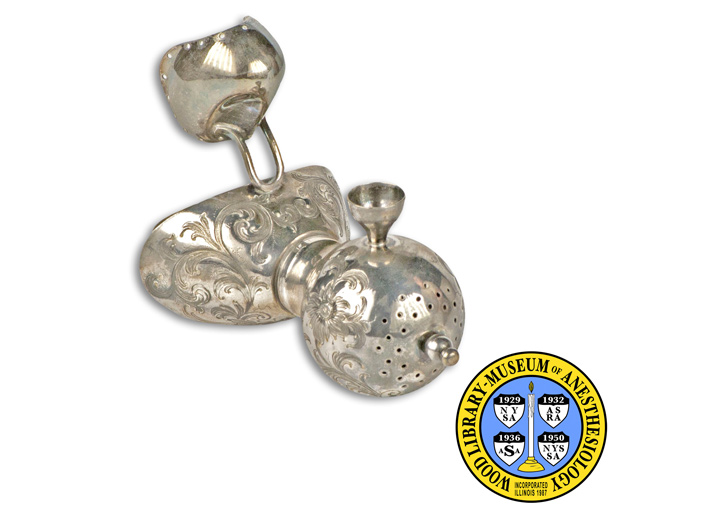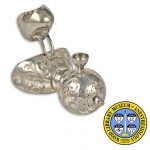Elser Chloroform Inhaler
Because of its small size, this inhaler was likely used to administer chloroform. The spherical chamber can be opened to insert a chloroform soaked sponge. To inhale the vapor, the patient would have placed his teeth and lips around the inner part of the mouth-piece, with the nasal cap against his nose to occlude the nostrils.
This is the only known example of this inhaler, and little is known about its origins. Its small size and detailed ornamentation make it very unique. Its closest comparison may be the 1848 Elser Chloroform Inhaler, designed in Strasbourg. This inhaler was acquired with a wooden case marked with, "F. C. BARLOW, D.D.S., 846 JERSEY AVE., JERSEY CITY". How Frederick C. Barlow came to possess the inhaler is unknown. We do know that Barlow was a dentist and active at various levels in his profession. Records indicate that he held posts in the New Jersey State Dental Society, the Central Dental Association of Northern New Jersey, and the New Jersey State Board of Dentistry.
Catalog Record: Elser Chloroform Inhaler
Access Key: aiqa
Accession No.: 2005-12-31-1
Title: [Elser Chloroform Inhaler].
Title variation: Alt Title
Title: Barlow inhaler.
Title variation: Alt Title
Title: Barlow’s inhaler.
Publisher: [S.l. : s.n., 1848-1890.]
Physical Description: 1 inhaler ; silver-plated metal : 9 x 7 x 11.5 cm.
Subject: Inhalers, Anesthesia.
Subject: Anesthesia, Inhalation.
Subject: Anesthesia, Dental.
Subject: Chloroform.
Note Type: General
Notes: Title determined by Dr. George Bause, the WLM Honorary Curator; The alternate
titles are based on markings in the case for the inhaler; No manufacturer
markings are on the inhaler itself.
Note Type: General
Notes: The range for the possible date of manufacture is based on an early estimate
(1860) of Elisabeth Bennion in her 1986 publication, Antique Dental
Instruments; The later date is generous and based on evidence in publications
that the dentist Frederick C. Barlow was actively participating in
professional activities, as a member of the New Jersey State Dental Society
Legislative Committee, in the early 1890’s (Meeker, 1893).
Note Type: With
Notes: With a wooden case lined with velvet and satin; The case is approx. 10 cm
wide and 15 cm deep; The lid has a gentle, convex, downward slope from back
to front, with the back of the case approx. 9 cm in height and the front of
the case approx. 5.5 cm in height; The lid is hinged in the back and in front
has two hook-like clasps to hold the lid closed; A fabric label on the inside
of the case is marked with, “F. C. BARLOW, D.D.S. [new line] 846 JERSEY AVE.,
[new line] JERSEY CITY”.
Note Type: Citation
Notes: Bennion E. Antique Dental Instruments. London: Sotheby’s Publications,
1986:98.
Note Type: Citation
Notes: Duncum BM. The Development of Inhalation Anaesthesia. London: Royal Society
of Medicine Press, 1994:504.
Note Type: Citation
Notes: Luckey BF. Central Dental Association of Norther New Jersey. Dental Cosmos.
1884;26(4):238.
Note Type: Citation
Notes: Meeker CA. New Jersey State Dental Society. Dental Cosmos. 1893;35(4):321.
Note Type: Citation
Notes: The New-Jersey Dentists. The New York Times. July 20, 1883. https://query.
nytimes.com/mem/archive-free/pdf?res=F10E11F6395411738DDDA90A94DF405B8384F0D3
Accessed November 29, 2010.
Note Type: Citation
Notes: State of New Jersey. Manual of the Legislature of New Jersey: One Hundred and
Sixteenth Session, 1892. Trenton, N.J.: T.F. Fitzgerald, 1892:828, 289, 395.
Note Type: Physical Description
Notes: This description is based on a patient’s perspective, with the mouth-piece
being the most proximal portion; The silver plating on the inhaler is covered
with elaborate floral engraving; The distal portion of the inhaler is
spherical and approx. 4.5 cm in dia.; At the top of the sphere is a small
funnel-shaped aperture for adding anesthetic; The most distal end of the
sphere is punctured with little holes in a circular area; A sponge sits
within the sphere, and can be separated from the mouth-piece by twisting the
two pieces; The proximal end of the sphere has a threaded female-connection;
The distal end of the mouth-piece has a threaded male-connection; The
exterior of the mouth-piece is approx. 7 cm wide, and is shaped to cover the
mouth; An inner tubular piece, approx. 4 cm wide and 1.5 cm high, extends for
the teeth and lips to encompass; In the center of the tubular extension, near
the connection to the sphere, a metal ‘wall’ or divider is punctured with 9
holes which offer the only opening between the mouth-piece and the sphere;
Raised above the mouth-piece by a thin strip of curved metal is a nose-shaped
cap to plug the nostrils; The nasal cap is approx. 3.5 x 3 x 3.5 cm in size;
Small rivet-like holes line the rim of the nasal-cap (if leather or fabric
once cushioned the rim of the cap it is no longer present).
Note Type: Reproduction
Notes: Photographed by Mr. William Lyle, July 27, 2010.
Note Type: Historical
Notes: It is not known whether Frederick C. Barlow commissioned the inhaler,
designed it or simply owned it. We do know that he was a dentist, in Jersey
City, New Jersey, and active at various levels in his profession. He served
on the New Jersey State Dental Society Board of Examiners in 1883-1884
(New-Jersey Dentists …, 1883). He served as president of the Central Dental
Association of Northern New Jersey during 1884, and on the Legislative
Committee of the New Jersey State Dental Society in 1893 (Luckey, 1884 ;
Meeker, 1893). Also, he was appointed to the New Jersey State Board of
Dentistry for 1892 (State of New Jersey, 1892).
Note Type: Historical
Notes: This is the only known example of this inhaler, and very little is known
about its origins. Its small size and detailed ornamentation make it very
unique. Its closest comparison may be the 1848 Elser Chloroform Inhaler,
designed in Strasbourg. The Elser Inhaler was described by Barbara Duncum and
pictured in The Development of Inhalation Anaesthesia (1994). The
similarities to the Elser end with the small, spherical anesthetic-chamber
punctured with little holes: The Elser inhaler is not decorated and its
sphere is composed of two pieces, whereas the Barlow sphere is a single piece
The Elser has an oronasal-mask, while the Barlow has a mouth-piece. Also,
the Elser has inspiratory and expiratory valves whereas the Barlow seems to
have neither. For another image of the Elser inhaler see Charles-Emmanuel
Sédillot’s 1848 publication, De l’insensibilité Produite par le Chloroforme
et par l’éther et des Opérations Sans Souleur.





